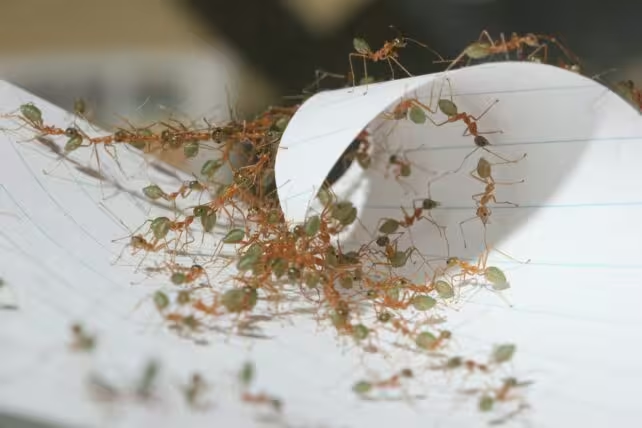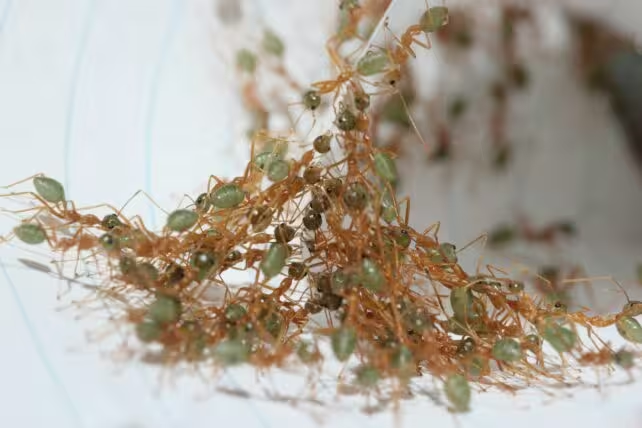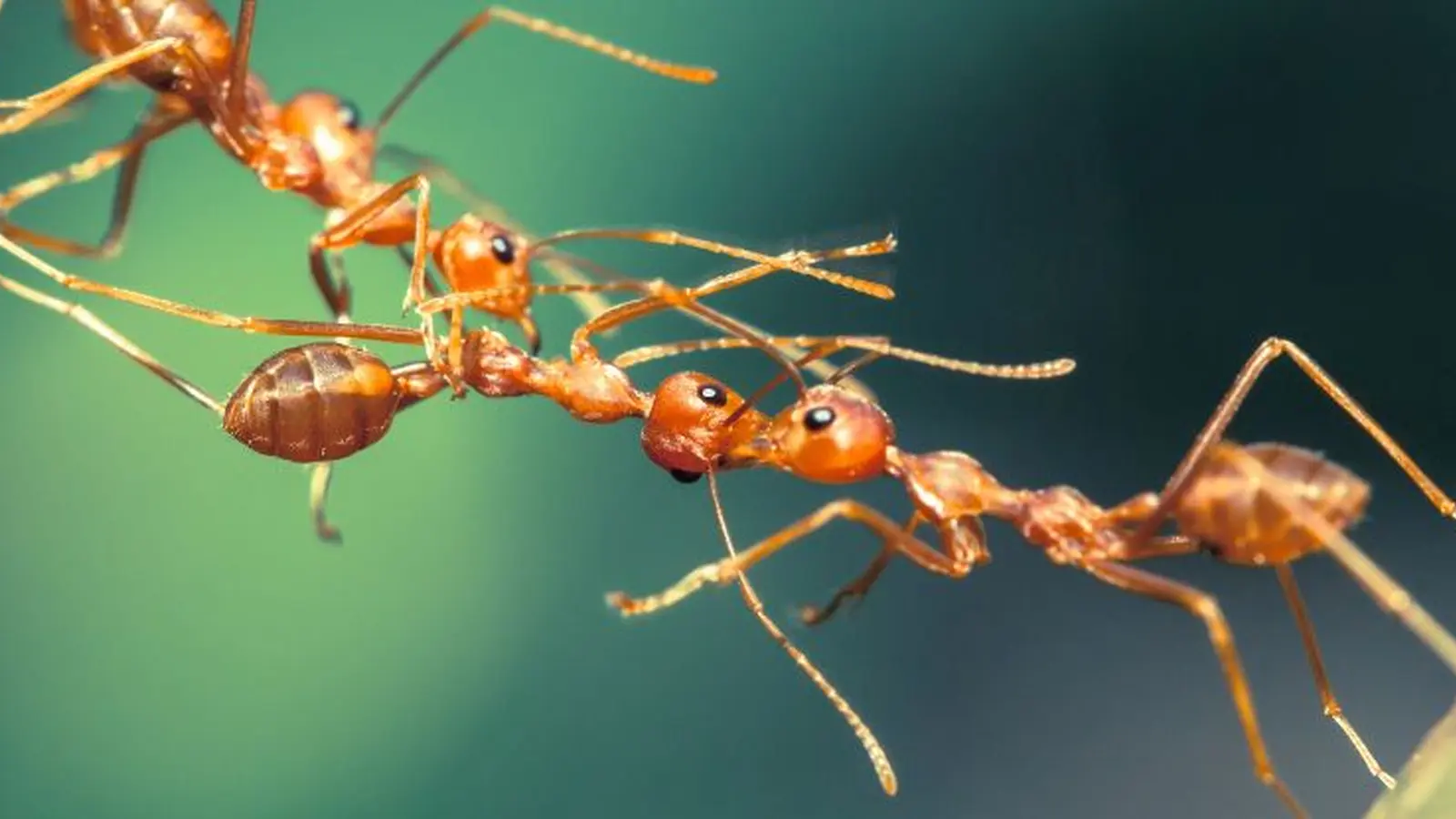6 Minutes
When more really is different
Ants are among nature's most accomplished cooperative engineers. For decades, researchers have described a common human teamwork problem known as the Ringelmann effect: as group size increases, the average contribution of each individual tends to decline due to coordination difficulties and social loafing. Yet many social animals—from schooling fish to hunting mammals—coordinate at large scales without obvious loss of performance. A recent study of weaver ants (Oecophylla smaragdina) reveals a striking exception: when these ants link into pulling chains to drag and shape leaves, individuals become more effective as the group grows. This article examines the experimental design, the proposed biomechanical mechanism called the "force ratchet," and the broader implications for collective behavior, biomechanics, and swarm robotics.
Scientific background: Ringelmann effect and animal collective behavior
The Ringelmann effect, first quantified by French engineer Max Ringelmann in the late 19th century, showed that total group output (for example, pulling a rope) increases with team size while per-person effort declines. Social psychologists later attributed the decline to reduced individual accountability and coordination losses. In animal systems, similar trends have been observed: some species demonstrate decreased per-capita contribution in larger cooperative assemblages. Yet eusocial insects such as ants routinely coordinate in colonies with thousands to millions of members, performing tasks from foraging to nest building. Weaver ants are an especially dramatic example: they construct leafy nests in tree canopies by pulling live leaves together and fastening them with larval silk, relying on linked pulling chains that resemble biological ropes.
Experiment details: measuring collective pulling force
To quantify how weaver ant chains scale performance with size, researchers coaxed ant chains to pull an artificial paper leaf attached to a force meter. The meter recorded continuous force output while ants joined and left chains, allowing analysis of instantaneous group force and per-ant contribution. Researchers expected to observe Ringelmann-like declines based on prior studies of other ants—fire ant rafts, for instance, showed decreased resistance per ant with increasing group size. Instead, the data revealed two surprising patterns: total force rose as chains lengthened (as expected), and the average force per ant also increased. Rather than social loafing or coordination loss, weaver ants displayed what the authors described as "superefficiency": individuals performed more work when embedded in larger chains.

Posture, arrangement, and division of labor
High-resolution observation showed that ant position within a chain correlated with distinct postures and roles. Rear ants extended their hind legs and adopted a stance that increased friction and resistance against slipping—functionally passive anchors. Middle and front ants crouched and actively pulled. This spatial partitioning suggested a simple but powerful division of labor: passive rear members boost ground contact and prevent slippage, enabling front pullers to apply greater force without yielding.
Mechanism: the force ratchet hypothesis
The study introduces the "force ratchet" as a mechanistic explanation. In isolation, an ant's maximum pull is limited by its grip friction with the substrate—beyond that, the ant slips and cannot transmit extra force. In a chain, however, rear ants increase the effective friction budget for the group, acting as passive resistors. Their foothold prevents backsliding and allows front ants to pull harder; the chain itself transmits and stores the amplified force. This ratchet-like locking of mechanical advantage means that additional members can create nonlinear gains in per-capita force, making the group more than the arithmetic sum of individuals.
Key discoveries and implications
The core discoveries are twofold: (1) weaver ant chains avoid the Ringelmann decline in per-capita effort and instead show increased individual effectiveness with group size; (2) a biomechanical division of labor—the force ratchet—appears to underlie this superefficiency. These findings reshape how we think about physical teamwork in biological collectives and suggest that proper spatial organization and role differentiation can convert potential coordination losses into multiplicative performance gains.
Applications for robotics and collective systems
The results have immediate relevance to swarm robotics and engineered collective systems. Current multi-robot teams often scale linearly: twice the robots produce roughly twice the force. That scaling avoids the Ringelmann pitfall, but it also misses the superefficiency ants demonstrate. Implementing ant-inspired strategies—such as programmed passive anchoring, dynamic chain formation, or substrate-contact optimization—could allow robot swarms to achieve supra-linear performance. This would be particularly valuable for applications in search-and-rescue, modular manipulation, and cooperative load transport where slipping and anchor stability limit task success.

Future experiments and open questions
The force ratchet model is compelling but remains partly speculative. Critical follow-up experiments include manipulating substrate friction, systematically varying load mass, and testing chains under dynamic perturbations. Comparative work across ant species and across other cooperative invertebrates would reveal whether the force ratchet is unique to weaver ants or a broader adaptive strategy. Integrating kinematic tracking and contact-force mapping will also refine how individual postures convert into group-level mechanics.
Expert Insight
"This study highlights how physical constraints can be turned into collective advantages through simple role allocation," says Dr. Maya Fernandes, a roboticist specializing in distributed systems. "For autonomous swarms, the lesson is clear: embedding passive stabilization behaviors and optimizing agent placement can unlock nonlinear performance gains. Nature’s designs provide blueprints that engineers should test in hardware and field trials."
Conclusion
Weaver ants demonstrate that cooperatives can overcome common human-like coordination problems when individual roles and spatial arrangements are optimized for the task. By forming single, elongated chains and segregating passive anchoring from active pulling, these ants convert individual friction and grip into a collective mechanical advantage—the force ratchet. The finding challenges the universality of the Ringelmann effect for physical teamwork and points toward biologically inspired strategies for improving swarm robotics, cooperative machines, and engineered collective transport. In short, when it comes to pulling power, more can indeed be different—and sometimes, more really is better.
Source: theconversation


Leave a Comment